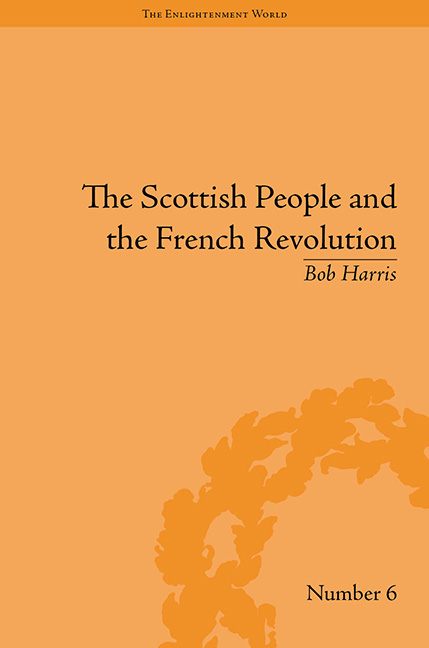Book contents
- Frontmatter
- CONTENTS
- Preface
- Introduction
- 1 The Eighteenth-Century Roots of Scottish ‘Jacobin’ Politics
- 2 Newspapers, the French Revolution and Public Opinion
- 3 ‘The True Spirit of Liberty’: Scottish Radicals, 1792–4
- 4 Checking the Radical Spirit
- 5 Volunteers, the Militia and the United Scotsmen, 1797–8
- 6 Bread, Dearth and Politics, 1795–1801
- Conclusion
- Notes
- Works Cited
- Index
1 - The Eighteenth-Century Roots of Scottish ‘Jacobin’ Politics
- Frontmatter
- CONTENTS
- Preface
- Introduction
- 1 The Eighteenth-Century Roots of Scottish ‘Jacobin’ Politics
- 2 Newspapers, the French Revolution and Public Opinion
- 3 ‘The True Spirit of Liberty’: Scottish Radicals, 1792–4
- 4 Checking the Radical Spirit
- 5 Volunteers, the Militia and the United Scotsmen, 1797–8
- 6 Bread, Dearth and Politics, 1795–1801
- Conclusion
- Notes
- Works Cited
- Index
Summary
The extent to which popular radicalism in the 1790s should be seen as a new departure in the political culture of the British Isles has long been a topic of lively debate among historians. The current consensus seems to be that in England the lines of continuity with preceding decades were strong ones, although, as John Stevenson cautioned some years ago, considerable gaps exist in our knowledge. Stevenson noted that the artisan world of tavern clubs and dissenting congregations between the era of Wilkes and the 1790s had only been dimly illuminated by research, while relatively few studies had been forthcoming of the worlds out of which sprang many of the provincial radical societies of the 1790s. Since he wrote this (in the late 1980s), little in this regard has changed. Nor, even where it can be shown to have taken place, did the participation of lesser tradesmen and artisans in political debate and activity in an earlier period guarantee that a strong radical presence would emerge in the 1790s. Birmingham saw a lively popular politics develop in the 1760s and ’70s under a Wilkite-inspired platform of ‘independence’, but radicals in the city in the 1790s appear to have been an isolated, tiny minority with only a flickering existence as an organized body. It is the development of political life in the large unrepresented towns such as Manchester, Sheffield and Leeds in the later eighteenth century which, by and large, remains least well understood. Such places did not produce petitions in support of parliamentary reform in 1783 or indeed 1785, a fact which raises difficult questions about attempts to trace lines of development back from the 1790s into the previous decade or indeed earlier. More generally in explaining the rise of popular radical societies in the 1790s, much seems to have depended on particular, local configurations of political forces and conditions, and, in the early phases, on the existence of leadership drawn from among the middling sorts and, on occasion, the landed classes.
- Type
- Chapter
- Information
- The Scottish People and the French Revolution , pp. 13 - 44Publisher: Pickering & ChattoFirst published in: 2014



